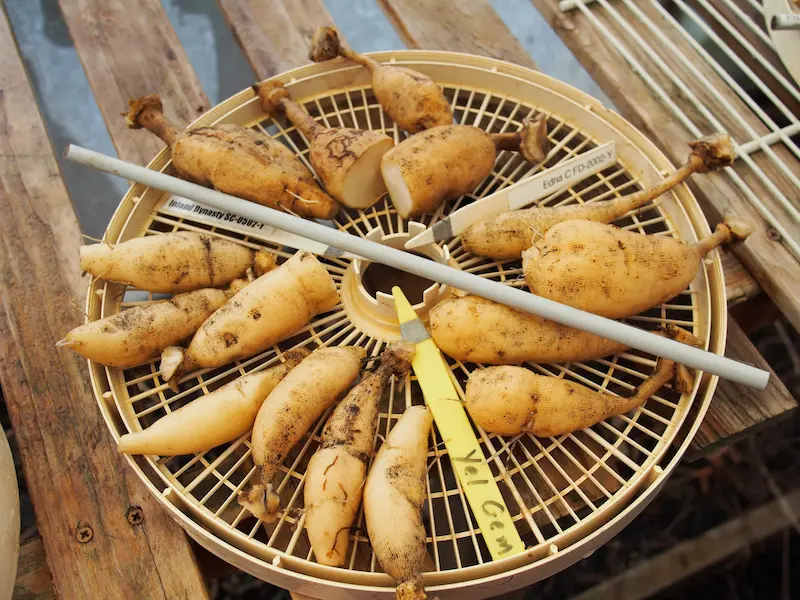Your cart is currently empty!
Get Event Reminders…
…twice a month by subscribing to our newsletter
Subscribe using the form in the page footer below.
Your cart is currently empty!
…twice a month by subscribing to our newsletter
Subscribe using the form in the page footer below.
Dahlia plants store food and energy on their roots and underground stems called tubers. Oblivious individuals might even mistake these clumps of tubers for sweet potatoes. I was stupidly convinced about how the plants could only be grown using tubers during my early years. However, unlike many regular flowering plants, Dahlias can be grown using seeds as well as Dahlia tubers.

When grown in a nursery, we avoid planting the Dahlia Tubers on cold soil during winter. Dahlias that are medium to dwarf-sized work well in containers as well. When the soil is warm during late spring, prepare the soil with a mixture of fertilizers and lightly water the mixture. Dig a 5 to 8-inch deep hole on the pot’s soil. Plant the tubers and fill the hole with 1 to 2 inches of soil.
Before planting, the tubers need to be cut from the clump’s base and should not be rotten or wrinkled. Wait until the sprouts appear above the soil before watering the tubers. Watering them too soon encourages rot. When they sprout, fill the rest of the hole for a healthy plant.
After about five weeks, it is time to transfer the plant. Dahlias require well-drained and rich soil. If the soil is dense or heavy, mixing it with aged manure would help the growth. Taking the stemmed Dahlias and planting them 10 to 14 inches apart would be appropriate when repotting.
It is important to choose a location with enough sunlight and to water Dahlias consistently. The use of Nitrogen-rich fertilizers during their growth can make Dahlia leaves grow at a much faster rate, delaying flower development. If done properly, you should have healthy and beautiful Dahlia flowers blooming in no time.
Dahlias can be grown as annuals in zones 2-7. They grow as perennials in zones 8-11 where they need little or no winter protection.
Dahlia tubers must be preserved by opportunist gardeners because to their inability to survive in cold winter soil for an extended period of time. To overwinter Dahlia tubers in winter hardiness zones, dig up and clean the tubers properly before applying fungicide. Afterward, store them in a packing bag, styrofoam ice chest, or large plastic bag with sand, cedar chips, or peat separating them.
Master gardener Judith Cox reveals an interesting way to collect dahlia seeds in a recent article.
Plant Anise, Artemisia, or Coriander with Dahlia to provide them with a cordial appearance. Not only do they go well with Dahlias, but they also promote healthy growth by repelling aphids and slugs. Complementary ornamentals such as Salvia, Geraniums, Roses, lilies, or Monarda mix well with Dahlia flowers during the growing as well as blooming season.
Logging in to comment gives you more features, but it is not required.
American Beech likes full sun at maturity and tolerates shade when young. Large space is necessary for wide-spreading root system.
Sharing a love of plants and the outdoors led them to escape to the country to allow the space to explore their passion for plants.
Small plants can grow in all sorts of hanging baskets. We’ll suggest some appropriate ways of growing these feisty vines and creepers.
Knowing about the best fertilizer for growing coffee plant becomes necessary for the plant to reach its fullest potential.
To eat my Red Malabar spinach, I pull the leaves off the vine at staggered intervals and enjoy it in a salad or as a treat in a stir-fry.
Admire the delicate and graceful harebell wildflower with its deep bluish-purple flowers, native to North America and Europe, that are eaten raw, used to make dye, and believed to give witches the power of transformation. A perfect addition to the rock garden that grows through summer and fall, and pollinated by hummingbirds, butterflies and bees.
In addition to salads, swiss chard is quite delicious as a warm side dish, and I am including a recipe for you to try.
Golden Alexanders (Zizia aurea) is an early spring bloomer and its yellow colours can be stunning in clusters.
Learning interesting tidbits of gardening facts can be as much fun as gardening itself. Share them with friends or intrigue your neighbour one day.
Even though Astilbe is typically known as a shade perennial, it tolerates full sun, as long as there is enough moisture.
It is time to clear up the mess left by chipmunks and salvage my garden. Join me as I describe my battle with nature, some tips for keeping chipmunks away, and prepare for the colourful blooms of peonies in this article.
Growing proper companion plants for tomatoes help growth, produce more flavour and protect fruits and vegetables from insects and pests.
GardeningCalendar.ca gets some funding from advertisers. If you click on links and advertisements at no cost to you, the site may receive a small commission that helps fund its operation.
© 2024 J&S Calendars Ltd.